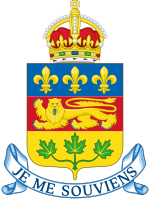
Back تاريخ مدينة كيبك Arabic Geschichte Québecs German Quebeceko historia Basque Histoire du Québec French Քվեբեկի պատմություն Armenian História do Quebec Portuguese История Квебека Russian Québecs historia Swedish Історія Квебеку Ukrainian 魁北克历史 Chinese
This article may need to be rewritten to comply with Wikipedia's quality standards. (November 2023) |
| History of Quebec |
|---|
 |
| Timeline |
| Territory of Quebec |
|
| Topics |
|
|
Quebec was first called Canada between 1534 and 1763. It was the most developed colony of New France as well as New France's centre, responsible for a variety of dependencies (ex. Acadia, Plaisance, Louisiana, and the Pays d'en Haut). Common themes in Quebec's early history as Canada include the fur trade — because it was the main industry — as well as the exploration of North America, war against the English, and alliances or war with Native American groups.
Following the Seven Years' War, Quebec became a British colony in the British Empire. It was first known as the Province of Quebec (1763–1791), then as Lower Canada (1791–1841), and then as Canada East (1841–1867) as a result of the Lower Canada Rebellion. During this period, the inferior socio-economic status of francophones (because anglophones dominated the natural resources and industries of Quebec), the Catholic church, resistance against cultural assimilation, and isolation from non English-speaking populations were important themes.
Quebec was confederated with Ontario, Nova Scotia, and New Brunswick in 1867, beginning the Confederation of Canada. Important events that mark this period are the World Wars, the Grande Noirceur, the Quiet Revolution (which improved the socio-economic standing of French Canadians and secularized Quebec), and the emergence of the contemporary Quebec sovereignty movement.
These three large periods of Quebec's history are represented on its coat of arms with three fleur-de-lis, followed by a lion, and then three maple leaves.